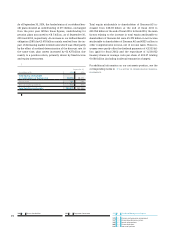Siemens 2014 Annual Report Download - page 220
Download and view the complete annual report
Please find page 220 of the 2014 Siemens annual report below. You can navigate through the pages in the report by either clicking on the pages listed below, or by using the keyword search tool below to find specific information within the annual report.
108 A. To our Shareholders 131 B. Corporate Governance 171 C. Combined Management Report
172 C. Business and economic environment
187 C. Financial performance system
193 C. Results of operations
205 C. Financial position
210 C. Net assets position
The R & D activities in the businesses of our former Healthcare
Sector are focused on meeting customer requirements, which
are the result of two major trends: the world’s population con-
tinues to grow steadily and to get older. These trends increase
the pressure on healthcare providers to treat more and more
people at increasingly lower costs in order to stabilize rising
healthcare expenditures. To overcome the challenges of mak-
ing healthcare more efficient and more effective, the health-
care measures have to focus on the individual patient and the
success of the treatment.
One of the R & D fields involves the development of systems that
help physicians make precise diagnoses of large numbers of
patients and are also robust, easy to use, and inexpensive to
purchase and maintain. Examples include interventional radiol-
ogy or catheter labs. Ultrasound with wireless transducers is
also ideally suited for minimally-invasive procedures such as
nerve blockades, access to blood vessels, and positioning for
therapeutic interventions and biopsies.
Another focus area is automating clinical work processes and
optimizing laboratory diagnostics, with a goal of enabling physi-
cians to identify diseases more precisely and at an earlier stage.
Physicians are then able to monitor the effect of medications
more accurately and benefit from the evaluation and analytical
capabilities of modern computer technology. As a result, thera-
pies can be tailored more closely to a patient’s needs. Healthcare
also develops products that meet the specific, targeted require-
ments of the healthcare systems of emerging countries.
One of the R & D priorities of the businesses in our former
Industry Sector is the software-based integration of product
development, production planning, production processes and
services within the framework of product lifecycle manage-
ment. The objective is to accelerate processes at every point
along the value chain. Innovative technologies can cut the time
from design to market in the manufacturing industry by up to
%. The further development of automation and drive tech-
nology, and industrial software in particular, plays a major role
here. This applies to the product development and production
process as well as to the integration of the drive system. More-
over, the businesses of the former Industry Sector are striving
to achieve greater energy efficiency, reduce raw material con
-
sumption, and lower emissions. These objectives also guide
the development of technology-based service concepts such as
energy management and remote maintenance systems.
R & D activities of the businesses in our former Infrastruc-
ture & Cities Sector focus on urban growth issues. Main research
fields therefore cover sustainable technologies for major metro-
politan areas and their infrastructures. The main aims are to in-
crease energy efficiency, reduce burdens on the environment,
increase cost-effectiveness, and improve the quality of life in
cities. To this end, the businesses develop building technologies
that conserve energy, solutions for ensuring an efficient and
secure supply of electricity in cities, and intelligent traffic and
transport systems. In addition, researchers are looking for ways
to integrate buildings into smart grids. Through such integration,
the buildings can feed the electricity they produce into the grids
and provide additional power during times of peak demand.
C.. Supply chain management
The principal goal of supply chain management (SCM) at
Siemens is to ensure the availability and quality of the materi-
als we require to serve our customers also considering innova-
tion strength and sustainability of our suppliers. We aim to
strengthen our competitiveness by achieving substantial sav-
ings in our purchasing volume. In fiscal , Siemens’ pur-
chasing volume amounted to approximately € billion, which
equaled roughly half of our total revenue. Our primary strate-
gies for achieving savings in purchasing include:
> Siemens-wide managed volume,
> Sourcing from emerging markets, and
> E-sourcing.
The successful restructuring of our SCM function since the end
of fiscal led to a substantial decrease of the cost for the
SCM organization, driven by optimizing towards a less complex
setup and process improvements. Going forward, we will con-
tinue with reshaping the SCM function in alignment with Vision
to support the new Siemens organization structure overall.
We also continue to strengthen Siemens’ innovation power by
benefiting from the innovative strength in our supplier net-
work. In May , we held our “
st
Siemens Supplier Innova-
tion Day,” the first event of its kind on Siemens corporate level.
With this event, we established a platform for regular dialogue
with our top innovative suppliers at the CEO level. With this
dialogue, we aim to increase our innovation capabilities, realize
shared growth potential and ensure long-term cost leadership.
Sustainability requirements – as a guiding principle for our
supply chain management – are an integral part of all relevant
supplier management processes – such as supplier selection,
supplier qualification and evaluation, and supplier develop-
ment. We require all of our suppliers to comply with the princi-
ples of our Code of Conduct for Siemens Suppliers, which in-
clude, besides others, respect for the basic rights of employees,
strong safety & health and environmental protection standards
as well as zero-tolerance on corruption & bribery. We also re-
quire them to support its implementation in their own supply
























